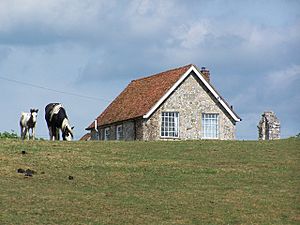Ivychurch Priory facts for kids
Ivychurch Priory was a medieval monastery located near Salisbury, in Wiltshire, England. Today, only a few parts of the old buildings remain. You can still see a round pillar with a fancy top and part of an archway. These old pieces are connected to the west wall of the church, which still has one support structure.
After monasteries were closed down in England, Ivychurch Priory became a private home. It belonged to the Herbert family, who were Earls of Pembroke. The famous writer Sir Philip Sidney wrote much of his well-known book, The Countess of Pembroke's Arcadia, while staying there. The priory was also close to Wilton House, a place known for its literary gatherings led by Mary Sidney Herbert.
History of Ivychurch Priory
The monastery at Ivychurch was run by Augustinian monks. It was sometimes called Monasterium Ederosum. People in 1274 believed it was started by King Stephen. It began as a small church connected to Alderbury church. There's a story that Thomas Becket, a famous Archbishop of Canterbury, stayed at the priory in 1164.
The monastery had a cloister, which is an open courtyard, from the 1100s. This cloister became part of the priory church. This church also served as the local church for people living in Clarendon Forest during the Middle Ages.
Over time, kings like King Edward III gave more land and money to the priory. By 1473, the priory owned at least 740 acres of fields and woods. They also owned land that used to belong to a smaller monastery called Upavon Priory. Ivychurch Priory also owned the manor of Whaddon and the right to choose the priest for the church there.
However, in 1397, when a leader named Prior Virgo was in charge, the priory faced money problems. The number of monks dropped to only two. King Richard II took away some of their lands and managed them himself. But the priory got its lands back later. By 1535, with the right to hunt small animals and pasture for 700 sheep, these lands were the richest part of the priory's property.
During the terrible Black Death plague, Ivychurch lost its Prior and twelve monks. Only one monk was left. Because there was no one else, King Edward III made him the new Prior. Even though the priory struggled under Prior Virgo, it became wealthy again in the 1400s. By 1536, it was doing well with a prior, five monk-priests, and one new monk. It even had some new buildings before it was closed down that same year. The last prior was Richard Page, who became leader in 1493.
After the Priory Closed
In March 1537, a man named Robert Seymour was given the right to use the priory, its lands, and manors for 21 years. This became a lifelong right in 1539. Later, in 1544, John Barwicke bought the right to own these lands after Seymour. Finally, the buildings came into the hands of Henry Herbert, 2nd Earl of Pembroke. He turned the priory into a private home.
Most of the priory buildings, including the old cloisters, stood until 1888. Then, they were taken down. A carved fireplace from the priory used to be in a local pub. Also, a water trough built in 1902 in Alderbury village has four old stone pillar tops. These likely came from the priory's cloisters.
One of the first people to live at Ivychurch after it became a private home was Sir George Penruddock. He was a local judge and a Member of Parliament for Wiltshire. He was also a trusted helper to the first Earl of Pembroke. Sir George was known for his bravery in battle.
Ivychurch house later belonged to Mary Sidney Herbert. She was a famous writer and supported other writers. She was also the sister of Sir Philip Sidney. It is believed that a large part of Sidney's famous book, The Countess of Pembroke's Arcadia, was written at Ivychurch. One writer described the beautiful views from Ivychurch, saying they helped Sir Philip Sidney's imagination. The priory also gave its name to a work by Abraham Fraunce. During the English Civil War, royalist soldiers held Ivychurch.
In 1985, the ruins of the priory were officially protected as a Grade II listed building. This means they are important and should be preserved.


